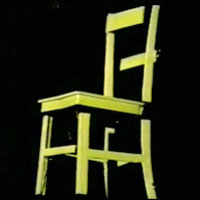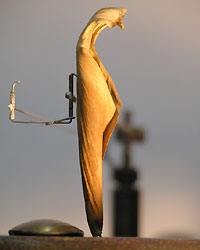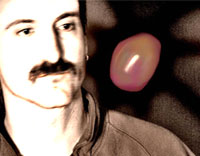
On this page, you'll find regularly updated audio, video, and text reports from our producers and correspondents. We invite you to join the discussion about topics covered here on our board and to subscribe to our audio and video podcasts to download these reports to your computer or MP3 player.

Click on the image to see a short video that Arthur Ganson made showing five of his whimsical kinetic sculptures, including "Cory's Yellow Chair" (above). 
Click on the image for a slide show of still pictures of "Machine with Artichoke Petal" and four other Ganson creations. |
2.8.2005 Speaking With ObjectsThe impulse to "speak" with objects began when I was a child. I was very introverted, so I found myself retreating to my basement to make things for people. In one sense it became a primary way to communicate. As a pre-med/art student in college, I was first drawn to the idea of doing surgery because it would require extremely focused work with my hands. I was also interested in computer programming because it was a way to "build" things logically. The first machine, a complicated little wire system, came about somewhat accidentally as a response to a class assignment. The building of it tested my manual and logical abilities. Because it was sculpture, I was also free to express my feelings. My engineering ability and intuition have grown very slowly over the years, and most everything I know has come about by making lots of mistakes. Each machine seems to offer its own set of challenges and problems. The first machines were made only of wire and powered by hand-cranks. I wanted the viewer to touch them so that they would be a direct extension of the viewer's hands. Now most of the machines are powered by motors because the speed and consistency of motion is critical for the expression of the idea. In the NOVA scienceNOW segment on my work I spoke about the joy of addressing aesthetic and engineering issues simultaneously. These two aspects are inextricably linked, for every part of the machine must serve both a mechanical and visual function. For me, ideas occur randomly and are triggered by everything I see and experience. For example, "Machine with Artichoke Petal" [see slide show] was born when attempting to cook an artichoke in a microwave but forgetting to cover the bowl! In the end it was completely inedible, but I found the shapes of the dried petals to be both beautiful and suggestive. Some pieces, like "Cory's Yellow Chair" [see video clip], have their inception entirely within my mind. With this piece, I imagined the chair suddenly exploding with tremendous force into 12 pieces—and then watching the pieces slow down, reverse direction, and finally implode with a force equal to the explosion. Remaining whole for just an instant, the chair exploded again!
The process of building "Cory's Yellow Chair" was one of great compromise
because it is physically impossible to move the chair pieces in the way that I
had envisioned. Matter cannot start and stop instantaneously. After much
simplification and reorientation of parts, the piece that you see in the video
clip emerged. In retrospect, I see how its gesture expresses my feelings about
the fleetingness of the present moment. When is now?
Notes on the video clipThe opening credits feature a very early machine entitled "Insta-Art." As its hand-crank is turned, the various gears and linkages cause the pen to scribble on adding machine tape. Crank down how much "art" you want and tear it off at the bottom! "Machine with Chinese Fan" came about while daydreaming about the gesture of opening and closing the fan. The mechanism is based on a simple 4-bar linkage. "Machine with Wishbone" is the result of playing with my food. The shape of the wishbone suggested a cowboy who had been on his horse for too long. The simple mechanism delivers the "walking" action to the wishbone which is actually pulling the mechanism behind it. "Cory's Yellow Chair": See several paragraphs above. "Machine with Eggshells": Eggshells are really loud when you hit them back to back. You should try it! |
|||||||||||

Arthur Ganson has been making kinetic sculpture for 27 years, having received a BFA from the University of New Hampshire in 1978. He has exhibited his machines in galleries and museums in the United States and Europe. A former artist-in-residence at the Massachusetts Institute of Technology, he maintains an ongoing exhibition of sculpture at the MIT Museum in Cambridge. Recently he appeared as a cartoon bear on the animated children's series "Arthur," and his friends say the likeness is remarkable. Ganson is the inventor of the award-winning children's toy Toobers and Zots. He lives and works near Boston. More work may be seen at his Web site, www.arthurganson.com. |
||||||||||||
|
© | Created February 2005 |
||||||||||||